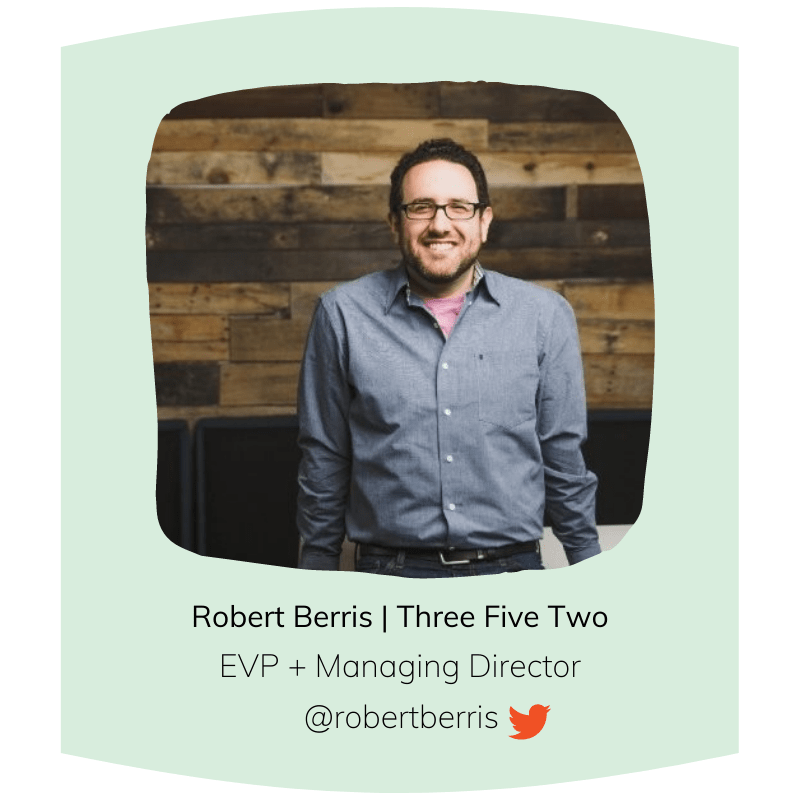Mastering Innovation + Avoiding Stagnation | #AskTheExperts
This past year taught marketers that innovating is essential to survival. We asked innovative marketing agency experts from Three Five Two and The Variable to weigh in with their philosophies on innovation and the best processes for brands to adopt an innovative mindset.
Q1 | What is your company's philosophy around innovation?
To be truly innovative is a mindset that needs to flow through the company’s processes and be supported and encouraged by key decision makers.
“We believe that more and more, innovation is the new marketing.”
“We believe that more and more, innovation is the new marketing,” shared Joe Parrish, the Partner and Chief Creative Officer at The Variable - three time winning AdAge Small Agency of the Year and one of Fast Company's 100 Best Workplaces for Innovators.
“CMO's are realizing that they can't spend their way out of a broken business model or a bad product design or a janky service model. For a company to succeed, they can no longer simply create demand for people to buy their thing; they need to create things that people demand.”
In order to innovate or pioneer real change, marketers need to do what they do best - lead with empathy and truly listen to create human-centered campaigns and solutions. The vision and mission of Three Five Two, another established innovative firm, is to “aspire to solve human-centered problems for people to make the world better.” In addition to making the world better, the marketing agency still strives to drive business growth.
Robert Berris, EVP and Managing Director of Three Five Two, shared, “We define innovation as the practice of uncovering and capitalizing on opportunities for strategic growth. However, our philosophy comes with constraints: we want to maximize the potential for companies by solving human-centered problems in pursuit of meaningful change.”
“Companies must make money to function, so if we can achieve that goal while solving problems that matter to people, it’s a win-win.”
Q2 | How do you approach innovation internally and how do you recommend clients approach innovation?
Innovation starts at home. Agencies like The Variable produce groundbreaking work not only for their clients, but internally as well to constantly push themselves to create and challenge their team.
“We are very intentional about innovation internally. Over time, we codified an innovation approach that led to us launching 8 companies over 3 years,” Parrish shared. “We are in the process of developing an innovation platform for clients to use that is based on our approach. Clients are realizing that while they may need better innovation partners, what they really need is a better internal innovation process. This platform will fill that need for them.”
Berris defines innovation as “strategic growth.” In order to focus on it internally, Three Five Two focuses on a mixture of elements - layering “the product management principles of customer desirability, market viability, and technical feasibility paired with the empathy-driven test and learning process of design thinking and the portfolio management approach to designing business models.”
As for client growth, Three Five Two recommends four tenets for innovation practices:
A clear definition of success,
Identification and clarity on which of the ten types of innovation are your focus area(s),
A strategy to support “how” your team does innovation (is it strategic program management, all in-house SMEs, etc) and,
A definition of “the right” problems you will work on with the pipeline to support it.
Berris emphasizes that a strategy backed by defined metrics and key performance indicators (KPIs) will sustain an innovative endeavor.
“All too often, soft metrics, loose definitions and a ‘creative’ structure leave innovation teams with short lifespans within larger organizations, and for good reason - it’s a completely different business model,” he shared. “The core business already has a strong profit model, an effective way to create value, and an offering the market buys and uses. An innovation team is actually a cost structure that operates outside of the core business model of the company and as a result, without strategic components to define why it’s important, it’ll be short lived. I’ve seen it fail far too often actually.”
“An innovation team is actually a cost structure that operates outside of the core business model of the company and as a result, without strategic components to define why it’s important, it’ll be short lived.”
Q3 | Can you share an example of an engagement with a client around innovation?
Three Five Two was brought in, not to simply do work on a product, but to help set up a large-scale, human-centered innovation organization within a company that hadn’t been driven by innovation in years - Nationwide.
The collaboration happened across multiple fronts. Berris shared that:
We helped their Chief Innovation Officer develop and iterate the transformative innovation process with an eye towards confidence and speed to market, while also coaching Nationwiders who were new to innovation as a whole.
We helped their innovation team evangelize the importance of customer-driven innovation, a critical mandate since development and go-to-market support rely on partnerships across the organization.
Across several projects, or Innovation pods, we helped to identify and develop transformative product opportunities with the goal of hundreds of millions in revenue over a five-year timeframe.
352 is still actively involved in evolving processes, creating internal Nationwide capabilities and growing transformative new ventures.
“Three Five Two frameworks and processes have been implemented across digital product development, marketing and data science to accelerate the company’s transition from Big Brand behavior to customer-centered agility. And, we’ve worked to build a team of more-capable innovators, marketers and developers focused on delivering value for customers and bottom-line results for the company,” said Berris.
Q4 | As clients develop an innovation pipeline, how do you commercialize those ideas?
“Through our work, we have learned the hard way what lots of innovative companies have learned over time: Ideas are easy. Execution is hard,” shared Parrish.
“Ideas are easy. Execution is hard.”
“We are in the ideas business, so we come up with a lot of them, but what separates Uber from some guy in his bedroom that had the same idea, is execution. We decided a few years ago to get serious about building out our execution capabilities. We launched a sister company called 100watt that specializes in just that. We call it ‘outsourced commercialization’ because we take an idea (whether ours or a clients), find product/market fit and develop a go-to-market/customer acquisition plan. We then run the company from MVP to seed-stage execution and create a strategy for next level growth (or pivot).”
There is nothing more true. Persistence and actually pursuing an idea makes all the difference when it comes to achieving a goal. Three Five Two echoes this statement by explaining that there are a number of problems to explore, but you must find the right one to pursue. Berris stated, “Putting effort into developing an innovation stage gate allows there to be intent and purpose within the process. Foundationally, the team must define the general activities and functions that take place, the roles and level of engagement for stakeholders, governance, and internal/external champions will matter as you validate the business case in support of commercialization.”
“It’s crucial to have the people, processes and technologies to support the innovation process.”
To build the pipeline, Berris focuses on:
Human-centered solutions.
“When we work with clients, I push them to solve problems for people and not be so hyper-focused on the solution. If you spend the time to understand your customer and market before you build the ‘thing,’ or make a concerted effort to not focus on the end-result but celebrate and value your learnings along the way, then you’ll build an innovation pipeline that actually fuels growth for your company.”
Creating alignment and a shared vision within the team.
“Prior to working on anything in your pipeline, your team’s executive sponsor along with others in management needed to align upon the elements required for a business case to acquire additional funding. Far too often we see elements missing because of visions of a shiny, new innovation center. A brand’s culture of innovation, and therefore their ability to commercialize a product, runs much deeper than brightly colored walls or a kombucha tap in the break room. It’s crucial to have the people, processes and technologies to support the innovation process.”
“Creating a shared vision with your team is important - this is where build, buy and partner strategies come into play - meaning, our role in assessing, developing and launching this innovation is dramatically different in ‘how’ you might accomplish this, and of course, the outcome you seek to achieve.”
Validating the investment.
“Assuming you’re largely building everything yourself, It’s critical that your pilot be limited in scope: product features, number of markets, and number of customers to continue to have some ‘controls’ in place that reduce the cost, time and risk of going too far too fast. Whether you want to frame it as learning fast or failing quickly, your goal isn’t perfection, your goal is continued learning to validate this investment is worth scaling.”
Continually test, learn, and collect feedback.
“You’ll need to create your initial go-to-market strategy with emphasis on agile marketing approaches to continuously test-and-learn as you’re in-market. As you start to acquire users, you’ll understand the best channels that provide the most value for your dollars and effort. You continue to go after the things that are working, and quickly eliminate those that aren’t.”
“Your product roadmap will continue to evolve as you’re in-market, and through customer feedback you’ll understand how to best evolve your product. Having the right data foundations laid will provide insights for evidence-based decision making, so you’re not making crucial business decisions by gut. As you continue to understand what’s working and not working, that’s how you make choices on where to optimize and eventually scale.”
Be confident in your decisions and acquire a strong team - they make all the difference!
“Often I explain to our clients and internal teams that within this process we’re actually solving for confidence. The confidence a business leader needs to make the next decision needs to be based on more evidence than they had the day before. I laugh and also say, plenty of business decisions have been made with lots of confidence and no evidence, and have still been successful. But that’s the exception, not the rule.”
“When you’re testing your product in-market, having the right team behind it makes all the difference.”
Innovation is not something that just appears out of nowhere like a fairy godmother. It must be nurtured, ingrained, and encouraged in the culture of a company. Once it is fostered, the mindset needs to be continuously challenged to determine if there is a firm strategy and beneficial outcome. Above all, innovation comes from meeting the needs of the consumer. The more human-centered your thought processes are, the more relevant and necessary solutions you will create.












Over the past year, we’ve watched the following patterns emerge across seemingly unrelated sectors: rising consumer expectations, demand for authenticity, growing complexity, and the tension between automation and human connection.
We interviewed multiple marketers from an array of industries in our blogs below, and we discovered consistent trends across the board. Check out all of our industry blogs throughout 2025 from leaders at Blackbaud, Hiscox USA, Mimedx, MONPURE, Kimberly-Clark Professional, and more.